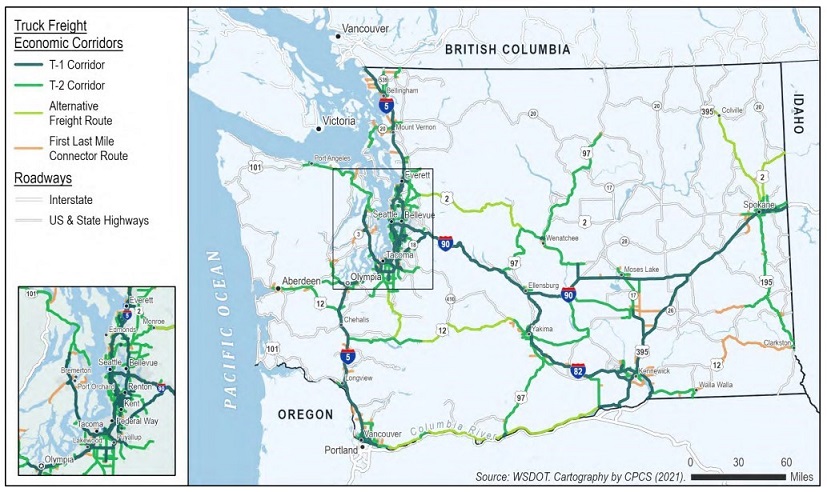Freight - Trucks
On this page:
Freight - Trucks
Source: U.S. Department of Transportation, Bureau of Transportation Statistics and WSDOT Rail, Freight, and Ports Division

Performance analysis
2023
Vehicle miles traveled by freight-trucks drops 1.0% in 2023
In 2023, Washington experienced a 1.0% decline in vehicle miles traveled (VMT) by freight-trucks, dropping from 3.54 million in 2022 to 3.51 million. The 2023 VMT also represented a 0.9% increase compared to pre-pandemic levels in 2019.
Washington experienced a 1.8% decrease in trucks entering from Canada in 2023
The number of freight trucks entering Washington from Canada decreased by 1.8%, from 621,055 in 2022 to 609,598 in 2023. In both years, the bulk of this traffic (a combined average of 82%) was at the Blaine and Sumas border crossings.
In 2023, 356,021 trucks entered Washington at the Blaine crossing on I-5, down 1.8% from the 362,569 that used this crossing in 2022. At the Sumas State Route 9 crossing, 142,594 trucks entered Washington in 2023, down 5.7% from 151,150 trucks in 2022.
Freight between Washington and Canada decreased by 5.6% for all modes
Transborder freight by all modes (including trucks, trains, and air) in Washington (represented as imports and exports between Washington and Canada) was valued at $30.6 billion in 2023, which was down 5.6% from $32.5 billion in 2022. The top five commodities imported and exported between Washington and British Columbia are machinery/appliance/reactors, wood products, mineral fuels/oils, animal/vegetable fats and oils, and special class provisions representing $5.77 billion in value.
2022
Vehicle miles traveled by freight-trucks drops 1.6% in 2022
Washington experienced a 1.6% decline in vehicle miles traveled (VMT) by freight-trucks, going from 3.6 million in 2021 to 3.5 million in 2022. However, the VMT for 2021 and 2022 increased 3.6% and 1.9%, respectively, compared to pre-pandemic levels in 2019.
Washington experienced a 2.7% decrease in trucks entering from Canada in 2022
The number of freight trucks entering Washington from Canada decreased by 2.7%, from 638,471 in 2021 to 621,055 in 2022. In both years, the bulk of this traffic (a combined average of 83.2%) was at the Blaine and Sumas border crossings.
In 2022, 362,569 trucks entered Washington at the Blaine crossing on I-5, down 5.3% from the 382,716 that used this crossing in 2021. The Sumas crossing on State Route 9 had 151,150 trucks enter Washington in 2022, down less than a percentage point from 151,670 trucks in 2021.
2021
Washington experiences a 5.1% increase in trucks entering from Canada in 2021
The number of freight trucks entering Washington from Canada increased by 5.1%, from 607,387 in 2020 to 638,471 in 2021. In both years, the bulk of the traffic (a combined average of 83.7%) was at the Blaine and Sumas border crossings.
In 2021, 382,716 trucks entered Washington at the Blaine crossing on I-5, up 13.4% from the 337,412 that used this crossing in 2020. The Sumas crossing on State Route 9 had 151,670 trucks enter Washington in 2021, down 2.2% from 155,013 trucks in 2020.
The border between Canada and the United States has remained closed to non-essential travel throughout 2021 due to the pandemic. However, as crossing protocols improved between 2020 and 2021, traffic became less congested at the popular Blaine crossing and many commercial trucking companies have shifted to using that crossing rather than alternatives.
2020
Washington sees a decrease in trucks entering from Canada in 2020
The number of freight trucks entering Washington from Canada decreased by 5.9%, from 645,732 in 2019 to 607,387 in 2020. In both years, the bulk of the traffic was at the Blaine and Sumas border crossings. In 2020, 337,412 trucks entered Washington at the Blaine crossing on I-5, down 8.8% from the 369,777 that used this crossing in 2019. The Sumas crossing on State Route 9 had 155,013 trucks enter Washington in 2020, nearly the same number as in 2019.
While the border between the United States and Canada was closed to non-essential travel for much of 2020 due to the COVID-19 pandemic, it remained open to freight traffic throughout the year. However, the two most rural border crossings, at Laurier and Metaline Falls, both saw substantial decreases in border crossings. Freight movements at both of these crossings are generally related to supplies for vacation related industries, which were heavily impacted by the pandemic.
2019
Number of trucks entering Washington from Canada decreases slightly from 2018 to 2019
The number of freight trucks entering Washington from Canada decreased by 1.5%, from 655,767 crossings in 2018 to 645,732 in 2019. In both years, the bulk of the traffic was at the Blaine and Sumas border crossings. In 2019, 369,777 trucks entered Washington at the Blaine crossing on Interstate 5, down 0.9% from 373,191 in 2018. The Sumas crossing on State Route 9 had 154,508 trucks enter Washington in 2019, a 1% decrease from 156,083 trucks in 2018.
In 2019, 81.2% of all freight trucks that entered Washington from Canada crossed the border at either the Blaine or Sumas crossings.
